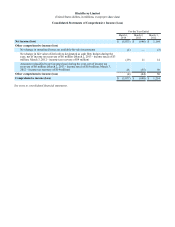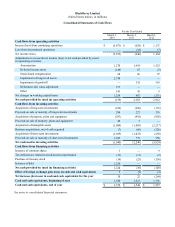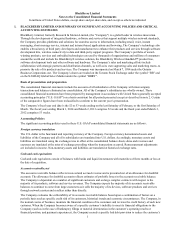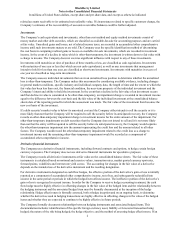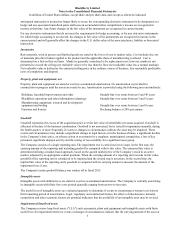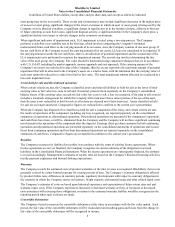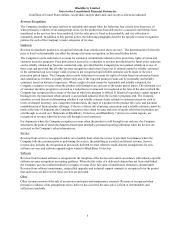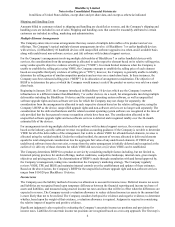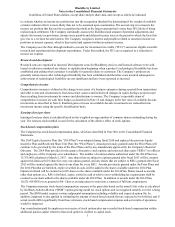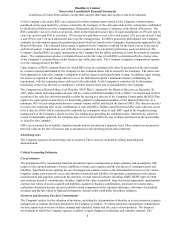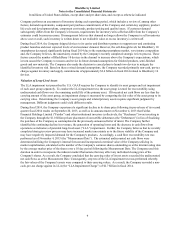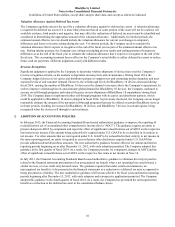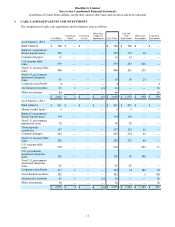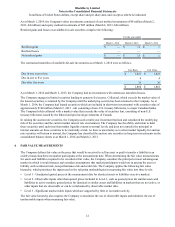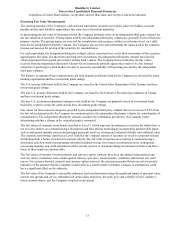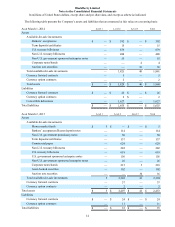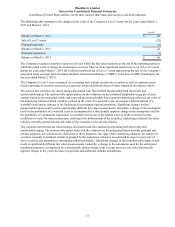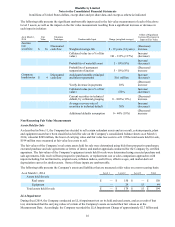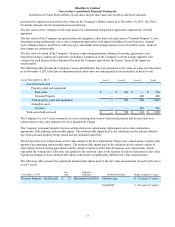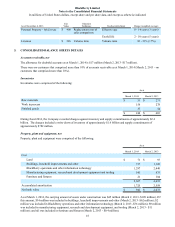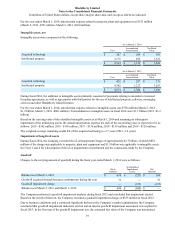Blackberry 2014 Annual Report Download - page 98
Download and view the complete annual report
Please find page 98 of the 2014 Blackberry annual report below. You can navigate through the pages in the report by either clicking on the pages listed below, or by using the keyword search tool below to find specific information within the annual report.BlackBerry Limited
Notes to the Consolidated Financial Statements
In millions of United States dollars, except share and per share data, and except as otherwise indicated
9
Company performs an assessment of inventory during each reporting period, which includes a review of, among other
factors, demand requirements, component part purchase commitments of the Company and certain key suppliers, product
life cycle and development plans, component cost trends, product pricing and quality issues. If customer demand
subsequently differs from the Company’s forecasts, requirements for inventory write-offs that differ from the Company’s
estimates could become necessary. If management believes that demand no longer allows the Company to sell inventories
above cost or at all, such inventory is written down to net realizable value or excess inventory is written off.
During fiscal 2014, the Company shipped devices to its carrier and distributor partners to support new and continuing
product launches and meet expected levels of end customer demand. However, the sell-through levels for BlackBerry 10
smartphones decreased significantly during fiscal 2014 due to the maturing smartphone market, very intense competition
and, the Company believes, the uncertainty created by the Company's recently completed strategic review process. These
factors caused the number of BlackBerry 10 devices in the channel to increase above the Company's expectations, which
in turn caused the Company to reassess and revise its future demand assumptions for finished products, semi-finished
goods and raw materials. The Company also made the decision to cancel plans to launch two devices to mitigate the
identified inventory risk. Based on these revised demand assumptions, the Company recorded primarily non-cash, pre-tax
charges against inventory and supply commitments of approximately $2.4 billion in fiscal 2014 related to Blackberry 10
devices.
Valuation of Long-Lived Assets
The LLA impairment test prescribed by U.S. GAAP requires the Company to identify its asset groups and test impairment
of each asset group separately. To conduct the LLA impairment test, the asset group is tested for recoverability using
undiscounted cash flows over the remaining useful life of the primary asset. If forecasted net cash flows are less than the
carrying amount of the asset group, an impairment charge is measured by comparing the fair value of the asset group to its
carrying value. Determining the Company's asset groups and related primary assets requires significant judgment by
management. Different judgments could yield different results.
During fiscal 2014, the Company experienced a significant decline in its share price following its pre-release of its second
quarter fiscal 2014 results on September 20, 2013, as well as its announcement on November 4, 2013 that Fairfax
Financial Holdings Limited ("Fairfax") and other institutional investors (collectively, the “Purchasers”) were investing in
the Company through the $1.0 billion private placement of convertible debentures (the "Debentures") in lieu of finalizing
the purchase of the Company as contemplated in the previously-announced letter of intent. The Company further
identified the continuing decline in revenues, the generation of operating losses and the decrease in cash flows from
operations as indicators of potential long-lived asset (“LLA”) impairment. Further, the Company believes that its recently
completed strategic review process may have increased market uncertainty as to the future viability of the Company and
may have negatively impacted demand for the Company's products. Accordingly, a cash flow recoverability test was
performed as of November 4, 2013 (the “Measurement Date”). The estimated undiscounted net cash flows were
determined utilizing the Company's internal forecast and incorporated a terminal value of the Company utilizing its
market capitalization, calculated as the number of the Company's common shares outstanding as at the interim testing date
by the average market price of the shares over a 10 day period following the Measurement Date. The Company used this
duration in order to incorporate the inherent market fluctuations that may affect any individual closing price of the
Company's shares. As a result, the Company concluded that the carrying value of its net assets exceeded the undiscounted
net cash flows as at the Measurement Date. Consequently, step two of the LLA impairment test was performed whereby
the fair values of the Company's assets were compared to their carrying values. As a result, the Company recorded a non-
cash, pre-tax charge against its LLA (the “LLA Impairment Charge”) of $2.7 billion in fiscal 2014.


